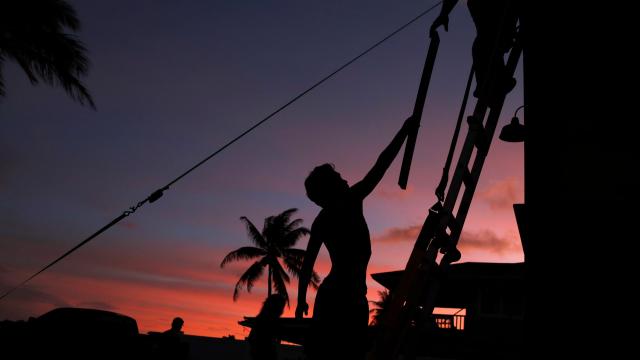Hurricane Lane continues to bear down on Hawaii, posing a catastrophic threat to residents and tourists alike. The storm could bring hurricane-force winds to the Aloha State for the first time in 26 years, along with pounding surf and torrential rain.
Hawaii has only seen three hurricanes reach its shores in the historical record. That could end up being both a blessing and a curse for residents living on the island as they prepare.
“Risks that feel unknown to an individual can increase someone’s risk perception, and perhaps, increase their attention to messages,” Gina Eosco, a social scientist supporting the National Oceanic and Atmospheric Administration’s (NOAA) Office of Weather and Air Quality, told Gizmodo. “On the other hand, given the rarity of such an event, some individuals may feel, ‘it won’t happen here.’ In other words, they’re using optimism bias.”
As of Thursday at 2am local time, Hurricane Lane was packing winds of 209km/h, making it a very dangerous Category 4. Every island is under a hurricane watch or warning and forecasters are calling for 25.4-50.8cm of rain over a large area. Some spots could pick up 76cm — nearly double Honolulu’s yearly rainfall — with rainfall rates approaching 10cm per hour.
Hilo has already recorded nearly a foot of rain, and landslides have been reported. Lane is chugging along at just 11km/h, allowing it to stir up large swells, and storm surge could top out at 1.22m.
To cap all this off, the strongest winds, rains, and surge impacts tend to occur on a hurricane’s northeast flank because of the way tropical cyclones rotate in the central Pacific. That’s right where the Hawaiian islands sit relative to Lane.
This is the direst forecast Hawaii has faced since Hurricane Iniki made landfall in Kauai in 1992. That storm caused $US3.1 ($4) billion in damage and left an indelible mark on Hawaiians’ memories. Having it as a touchstone could help ensure Hawaiians take Lane seriously.
“Hawaiians are pretty akamai, clued up,” John Marra, director of NOAA Pacific Regional Climate Services, told Gizmodo. “The impacts [of Iniki] imprinted on a lot of folks… We’re a little bit more aware than you might think.”
That awareness already has Hawaiians following the same sorts of preparations you’d expect to see along the Gulf Coast: boarding up windows, filling up petrol tanks, and stocking up on water and food. The state has requested and the federal government has already granted a disaster declaration, which could speed the response after the storm passes.
All that being said, Karl Kim, the head of the University of Hawaii’s National Disaster Preparedness Training Center, pointed out that certain groups remain very vulnerable. “[P]oor people, homeless, persons with disabilities, seniors, and immigrant communities may be at greater risk,” Kim told Gizmodo.
A May 2018 count estimates there are 6530 homeless people across the islands. Police in Honolulu are canvassing tent communities urging homeless to seek shelter ahead of the storm, but there are a lot of people to reach and not a lot of time left. People living in poverty could also wind up homeless after the storm, something Houston saw in the wake of Harvey.
Even the best preparations could still underestimate the impacts of Lane. Marra said the breadth of areas that will likely see massive rainfall totals could stretch resources thinner and leave people forced to fend for themselves for longer in flooded, muddy conditions.
Then there’s the infrastructure on the ground. The state also upgraded its building codes in 2010 so that all new residential construction must withstand wind gusts of up to 209km/h. But older buildings don’t have to be up to that code and are at-risk from both winds and flooding.
If those homes collapse or roofs rip off, the flying debris could put anyone in harm’s way. Marra also raised concerns about compound flooding from storm surge and rain that would have nowhere to go except into people’s basements.
All of which is to say, Lane could test Hawaii in ways Iniki did as well as new ways. If you’re in Hawaii, pay attention to the forecast and stay safe.
